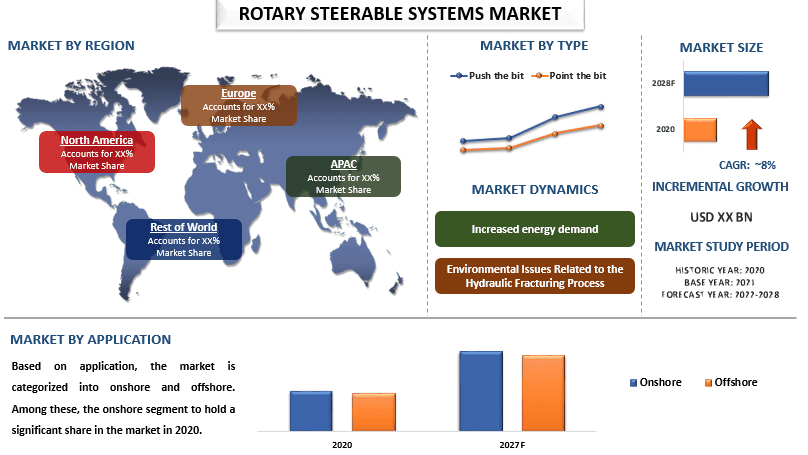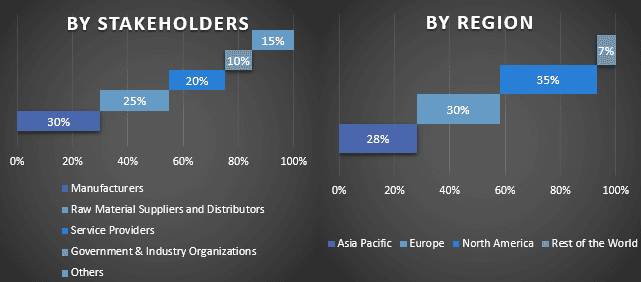- Inicio
- Acerca de nosotros
- Industria
- Servicios
- Leyendo
- Contáctenos
Mercado de Sistemas Rotatorios Dirigibles: Análisis Actual y Pronóstico (2022-2028)
Énfasis en el tipo (Empuje la broca, Apunte la broca); Aplicación (En tierra, Mar adentro); y Región/País

Se espera que el mercado mundial de sistemas rotatorios dirigibles crezca a una tasa significativa de más del 8% durante el período de pronóstico. Un sistema rotatorio dirigible es una técnica de perforación utilizada en el proceso de perforación direccional. En los últimos años, la demanda de sistemas rotatorios dirigibles ha aumentado drásticamente debido al aumento de las inversiones en el sector de la perforación en alta mar, así como a la creciente demanda de energía a nivel mundial. Como los sistemas rotatorios dirigibles utilizan el uso de equipos especializados de fondo de pozo para reemplazar las herramientas direccionales convencionales, como los motores de lodo. La demanda de nuevos campos petroleros se satisface significativamente con los sistemas rotatorios dirigibles de perforación de mayor calidad, lo que creará oportunidades lucrativas para el crecimiento del mercado de sistemas rotatorios dirigibles a nivel mundial. Por ejemplo, en noviembre de 2020, D-Tech lanzó su herramienta rotatoria dirigible (RST) Invictus. Este lanzamiento de producto permitirá a las empresas direccionales utilizar la RST con sus sensores de medición durante la perforación (MWD) preferidos para la comunicación en tiempo real en el fondo del pozo, brindando a todos los usuarios una mejor conciencia de las condiciones del fondo del pozo al menor costo.
Halliburton Company, Baker Hughes Company, Weatherford International plc, NOV Inc., Schlumberger Limited, APS Technology Inc., Nabors Industries Limited, Target Energy LLC, Double Barrel RSS, Leam Drilling Systems LLC. Estos actores han emprendido varias fusiones y adquisiciones junto con asociaciones para desarrollar el mercado de metano de lecho de carbón. Por ejemplo, en agosto de 2021, Schlumberger lanzó la perforación direccional autónoma. Este producto se utiliza para ayudar a los clientes a alcanzar nuevos niveles de eficiencia, consistencia y sostenibilidad en la construcción de pozos y fortalecer su segmento de cartera rotatoria dirigible.
Perspectivas presentadas en el informe
“Entre los tipos, la categoría de empujar la broca será testigo de una mayor CAGR durante el período de pronóstico”
Según el tipo, el mercado se segmenta en empujar la broca y apuntar la broca. El segmento de empujar la broca será testigo de una mayor CAGR durante el período de pronóstico debido a su fácil disponibilidad y bajo costo. La superficie exterior de la herramienta de empujar la broca tiene una almohadilla que empuja el agujero de perforación, lo que finalmente empuja la broca hacia el otro lado y cambia la dirección. Además, la entrada de actores globales en los mercados emergentes se suma al crecimiento del mercado. Por ejemplo, en noviembre de 2021, Halliburton lanzó iCruise X™ Intelligent Rotary Steerable System, la próxima generación de la plataforma de perforación dirigida a aplicaciones más largas y severas para brindar una buena colocación precisa y un tiempo de pozo reducido.
“Entre las aplicaciones, el segmento terrestre tendrá una participación significativa en el mercado en 2020”
Según el tipo de transmisión, el mercado se clasifica en terrestre y marítimo. Entre estos, el segmento terrestre tendrá una participación significativa en el mercado en 2020. Esto se debe principalmente a los métodos de perforación simples, los bajos costos de perforación, los bajos costos operativos, la gran disponibilidad de recursos y otros factores que impulsan el crecimiento del segmento terrestre en el mercado objetivo. En los últimos tiempos, se han encontrado reservorios tanto convencionales como no convencionales en grandes cantidades en la ubicación terrestre, lo que aumentará la demanda del mercado de sistemas rotatorios dirigibles durante el período de pronóstico.
“América del Norte tendrá una participación significativa en el mercado”
En 2020, se anticipa que América del Norte crecerá a una CAGR sustancial durante el período de pronóstico. América del Norte es uno de los principales mercados de sistemas rotatorios dirigibles, debido al aumento de las actividades de perforación y producción. América del Norte también es conocido como el mercado de petróleo y gas más importante. Además, la creciente inversión en petróleo y gas y el descubrimiento de nuevos campos de petróleo y gas, como el proyecto de perforación del Mar del Norte, impulsarán el crecimiento de los mercados regionales. Además, se espera que la creciente demanda regional de energía debido al crecimiento de la población regional y al ingreso disponible per cápita impulse el mercado durante el período de pronóstico. Además, en los EE. UU., los avances en la tecnología de perforación hidráulica han ayudado a los operadores a aumentar su producción de esquisto en esta región. Por lo tanto, el país es uno de los mercados más grandes para la perforación rotatoria dirigible. La aplicación de la perforación de secciones laterales en los EE. UU., Canadá y otros países juega un papel importante en la introducción del crecimiento del mercado de sistemas de rotación dirigible.
Razones para comprar este informe:
- El estudio incluye análisis de tamaño y pronóstico del mercado validados por expertos clave autenticados de la industria.
- El informe presenta una revisión rápida del rendimiento general de la industria de un vistazo.
- El informe cubre un análisis en profundidad de los pares prominentes de la industria con un enfoque principal en las finanzas comerciales clave, la cartera de productos, las estrategias de expansión y los desarrollos recientes.
- Examen detallado de los impulsores, las restricciones, las tendencias clave y las oportunidades que prevalecen en la industria.
- El estudio cubre de manera integral el mercado en diferentes segmentos.
- Análisis profundo a nivel regional de la industria.
Opciones de personalización:
El mercado mundial de sistemas rotatorios dirigibles se puede personalizar aún más según los requisitos o cualquier otro segmento de mercado. Además de esto, UMI entiende que puede tener sus propias necesidades comerciales, así que no dude en conectarse con nosotros para obtener un informe que se adapte completamente a sus requisitos.
Tabla de contenido
Metodología de Investigación para el Análisis del Mercado de Sistemas Direccionales Rotatorios (2022-2028)
El análisis del mercado histórico, la estimación del mercado actual y la previsión del mercado futuro del mercado global de sistemas direccionales rotatorios fueron los tres pasos principales realizados para crear y analizar la adopción de sistemas direccionales rotatorios en las principales regiones del mundo. Se llevó a cabo una exhaustiva investigación secundaria para recopilar las cifras históricas del mercado y estimar el tamaño actual del mercado. En segundo lugar, para validar estos conocimientos, se tomaron en consideración numerosos hallazgos y supuestos. Además, también se realizaron exhaustivas entrevistas primarias con expertos de la industria a lo largo de la cadena de valor del mercado global de sistemas direccionales rotatorios. Tras la suposición y validación de las cifras del mercado a través de entrevistas primarias, empleamos un enfoque de arriba hacia abajo/de abajo hacia arriba para pronosticar el tamaño total del mercado. Posteriormente, se adoptaron métodos de desglose del mercado y triangulación de datos para estimar y analizar el tamaño del mercado de los segmentos y subsegmentos a los que pertenece la industria. La metodología detallada se explica a continuación:
Análisis del Tamaño Histórico del Mercado
Paso 1: Estudio Profundo de Fuentes Secundarias:
Se llevó a cabo un estudio secundario detallado para obtener el tamaño histórico del mercado de sistemas direccionales rotatorios a través de fuentes internas de la empresa, como informes anuales y estados financieros, presentaciones de resultados, comunicados de prensa, etc., y fuentes externas, como revistas, noticias y artículos, publicaciones gubernamentales, publicaciones de la competencia, informes del sector, bases de datos de terceros y otras publicaciones creíbles.
Paso 2: Segmentación del Mercado:
Después de obtener el tamaño histórico del mercado de sistemas direccionales rotatorios, realizamos un análisis secundario detallado para recopilar información histórica del mercado y compartirla para diferentes segmentos y subsegmentos para las principales regiones. Los principales segmentos incluidos en el informe son el tipo y la aplicación. Además, se realizaron análisis a nivel de país para evaluar la adopción general de modelos de prueba en esa región.
Paso 3: Análisis de Factores:
Después de adquirir el tamaño histórico del mercado de diferentes segmentos y subsegmentos, realizamos un análisis de factores detallado para estimar el tamaño actual del mercado de sistemas direccionales rotatorios. Además, realizamos un análisis de factores utilizando variables dependientes e independientes, como varios tipos y aplicaciones de sistemas direccionales rotatorios. Se llevó a cabo un análisis exhaustivo de los escenarios de la demanda y la oferta, teniendo en cuenta las principales asociaciones, fusiones y adquisiciones, la expansión empresarial y los lanzamientos de productos en el sector del mercado de sistemas direccionales rotatorios en todo el mundo.
Estimación y Previsión del Tamaño Actual del Mercado
Tamaño Actual del Mercado: Basándonos en la información práctica de los 3 pasos anteriores, llegamos al tamaño actual del mercado, los actores clave en el mercado global de sistemas direccionales rotatorios y las cuotas de mercado de los segmentos. Todos los porcentajes de participación requeridos y los desgloses del mercado se determinaron utilizando el enfoque secundario mencionado anteriormente y se verificaron a través de entrevistas primarias.
Estimación y Previsión: Para la estimación y previsión del mercado, se asignaron ponderaciones a diferentes factores, incluidos los impulsores y las tendencias, las restricciones y las oportunidades disponibles para las partes interesadas. Después de analizar estos factores, se aplicaron técnicas de previsión relevantes, es decir, el enfoque de arriba hacia abajo/de abajo hacia arriba, para llegar a la previsión del mercado para 2028 para diferentes segmentos y subsegmentos en los principales mercados a nivel mundial. La metodología de investigación adoptada para estimar el tamaño del mercado abarca:
- El tamaño del mercado de la industria, en términos de ingresos (USD) y la tasa de adopción del mercado de sistemas direccionales rotatorios en los principales mercados a nivel nacional
- Todos los porcentajes de participación, divisiones y desgloses de los segmentos y subsegmentos del mercado
- Actores clave en el mercado global de sistemas direccionales rotatorios en términos de productos ofrecidos. Además, las estrategias de crecimiento adoptadas por estos actores para competir en el mercado de rápido crecimiento
Validación del Tamaño y la Cuota de Mercado
Investigación Primaria: Se realizaron entrevistas en profundidad con los Líderes de Opinión Clave (KOL) que incluyen a los Ejecutivos de Alto Nivel (CXO/VP, Jefe de Ventas, Jefe de Marketing, Jefe de Operaciones, Jefe Regional, Jefe de País, etc.) en las principales regiones. Los hallazgos de la investigación primaria se resumieron y se realizó un análisis estadístico para probar la hipótesis establecida. Los datos de la investigación primaria se consolidaron con los hallazgos secundarios, convirtiendo así la información en información práctica.
División de los Participantes Primarios en Diferentes Regiones

Ingeniería de Mercado
Se empleó la técnica de triangulación de datos para completar la estimación general del mercado y para llegar a cifras estadísticas precisas para cada segmento y subsegmento del mercado global de sistemas direccionales rotatorios. Los datos se dividieron en varios segmentos y subsegmentos después de estudiar varios parámetros y tendencias en las áreas de tipo y aplicación en el mercado global de sistemas direccionales rotatorios.
El principal objetivo del Estudio del Mercado Global de Sistemas Direccionales Rotatorios
Las tendencias actuales y futuras del mercado global de sistemas direccionales rotatorios se identificaron en el estudio. Los inversores pueden obtener información estratégica para basar su criterio para las inversiones en el análisis cualitativo y cuantitativo realizado en el estudio. Las tendencias actuales y futuras del mercado determinaron el atractivo general del mercado a nivel regional, proporcionando una plataforma para que el participante industrial explote el mercado sin explotar para beneficiarse de una ventaja de ser el primero en actuar. Otros objetivos cuantitativos de los estudios incluyen:
- Analizar el tamaño actual y previsto del mercado de sistemas direccionales rotatorios en términos de valor (USD). Además, analizar el tamaño actual y previsto del mercado de diferentes segmentos y subsegmentos
- Los segmentos en el estudio incluyen áreas de tipo y aplicación.
- Definir y analizar el marco regulatorio para los sistemas direccionales rotatorios
- Analizar la cadena de valor involucrada con la presencia de varios intermediarios, junto con el análisis de los comportamientos de los clientes y la competencia de la industria.
- Analizar el tamaño actual y previsto del mercado de sistemas direccionales rotatorios para la región principal.
- Los principales países de las regiones estudiadas en el informe incluyen Asia Pacífico, Europa, América del Norte y el resto del mundo.
- Perfiles de empresas del mercado de sistemas direccionales rotatorios y las estrategias de crecimiento adoptadas por los actores del mercado para mantenerse en el mercado de rápido crecimiento
- Análisis profundo a nivel regional de la industria
Relacionados Informes
Los clientes que compraron este artículo también compraron










